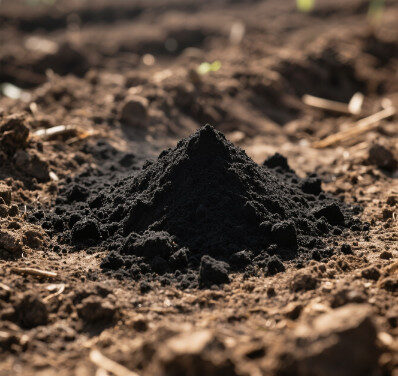Humic acids (HA), also known as humic acids or humic acid HA, represent a group of amorphous organic weak acids with relatively high molecular weight within humic substances. Characterized by their black or dark brown appearance, these compounds exhibit specific solubility properties – being soluble in dilute alkaline solutions but insoluble in acid and water. The sources of humic acids are diverse, obtainable both from mineral deposits such as weathered coal, lignite, and peat, as well as through chemical or microbial fermentation processes converting biomass byproducts from industrial and agricultural production.
1. Fundamental Properties and Formation
Humic acid (HA) is a naturally occurring macromolecular organic substance formed through:
-
Microbial decomposition and transformation of plant/animal residues
-
Long-term geochemical processes
-
Accumulation in various environmental matrices
Structural Characteristics:
-
Composed of aromatic rings with multiple functional groups
-
Appears as dark brown powder/granules with weak acidity
-
Typical composition (dry basis): N (1%), P₂O₅ (0.23%), K₂O (1.1%)
Classification:
| Type | Source | Description |
|---|---|---|
| Natural HA | Soil, peat, water systems | Naturally formed in ecosystems |
| Artificial HA | Industrial production | Includes: |
| • Regenerated HA (coal weathering/oxidation) | ||
| • Synthetic HA (non-coal precursors) |
2. Global Distribution and Market Outlook
Major Chernozem Regions:
-
Ukrainian Plain
-
Mississippi River Basin (North America)
-
Songliao Basin (China)
Market Projections:
-
2024 market value: $790 million
-
2029 projected value: $1.38 billion
-
CAGR (2024-2029): 11.61%
3. Agricultural Functions and Mechanisms
3.1 Soil Structure Improvement
-
Forms stable organo-mineral complexes
-
Enhances soil porosity (aeration improvement ≥25%)
-
Increases water holding capacity (15-30% improvement)
3.2 Nutrient Enhancement
-
Cation exchange capacity (CEC): 150-300 meq/100g
-
Nutrient retention mechanisms:
-
NH₄⁺ stabilization via hydrophobic interactions
-
PO₄³⁻ fixation through Fe/Al bridging
-
K⁺ chelation by carboxyl groups
-
3.3 Plant Growth Promotion
-
Root development: ↑25-40% root biomass
-
Stress resistance enhancement:
-
Drought: Proline accumulation ↑30-50%
-
Salinity: Na⁺ exclusion efficiency ↑20-35%
-
Temperature: Cell membrane stability improvement
-
3.4 Quality Improvement
-
Nutritional quality parameters:
-
Vitamin C content: ↑15-25%
-
Soluble solids: ↑1-3°Brix
-
Nitrate reduction: ↓20-40%
-
3.5 Slow-Release Properties
-
Nutrient release kinetics:
-
N: 60-80% release over 60-90 days
-
P: 50-70% available P preservation
-
-
Pesticide adsorption capacity: 5-15mg/g
3.6 Microbial Activation
-
Microbial biomass carbon: ↑30-50%
-
Enzyme activities:
-
Urease: ↑20-45%
-
Phosphatase: ↑15-35%
-
Catalase: ↑10-25%
-
4,Humic Acid (HA) VS Fulvic acid(FA)
Fulvic Acid (FA)
Fulvic acid (FA), also known as fulvic acid or fulvic acid FA, is a group of amorphous organic weak acids with relatively low molecular weight within humic substances. Its dilute solution appears yellow or brown-yellow and is soluble in dilute alkaline solutions, acids, and water. FA can be extracted from mineral sources such as weathered coal, lignite, and peat through chemical processes, or derived from industrial and agricultural biomass byproducts via chemical or microbial fermentation.
Comparison Between Fulvic Acid and Humic Acid
Fulvic acid is distinguished by its small molecular weight and excellent solubility, allowing it to dissolve easily in acids, alkalis, and water, while maintaining high compatibility with other products. In contrast, humic acid (HA), though derived from the same sources, has a larger molecular structure and varies in solubility (alkali-soluble, acid-insoluble, and water-insoluble). Both substances originate from mineral and biological sources.
Physically, humic acid appears black, whereas fulvic acid is yellow—a key distinguishing feature in practical applications. Although both are essential components of humic substances, fulvic acid often demonstrates superior performance due to its small molecular size and enhanced solubility.
Fertilizer Products Containing Humic Acid
Sodium Humate & Potassium Humate Characteristics
-
Sodium Humate: Produced from weathered coal, lignite, or peat through reaction with sodium hydroxide (NaOH). However, its use is not recommended due to potential soil salinization.
-
Potassium Humate: Derived from mineral-based humic acid and refined via reaction with potassium hydroxide (KOH). This black powder, flake, or granular solid enhances soil water retention and stimulates microbial activity, promoting crop growth.
Preparation and Properties of Potassium Fulvate
Definition: Potassium fulvate is produced from weathered coal, lignite, peat, plant straw, sawdust, bagasse (liquid), or food waste through extraction or biofertilization, followed by reaction with potassium hydroxide (KOH) or other compounds.
Sources:
-
Mineral-derived potassium fulvate
-
Bio-derived potassium fulvate
Qualitative Analysis:
Fluorescence spectrophotometry is used to scan emission spectra at different excitation wavelengths, identifying the maximum and matching fluorescence excitation/emission spectra for characterization.
5. Agricultural Applications and Benefits
Field Performance:
-
Yield increases: 8-25% across major crops
-
Fertilizer use efficiency: ↑15-30%
-
Water use efficiency: ↑20-40%
Environmental Benefits:
-
Carbon sequestration: 0.5-1.2 t C/ha/yr
-
Heavy metal immobilization: Cd/Pb reduction by 30-60%
-
Pesticide residue degradation: ↑25-50%
6. Future Perspectives
-
Emerging technologies in HA extraction/purification
-
Nano-humic acid formulations
-
Precision agriculture applications
-
Climate-smart agriculture integration









